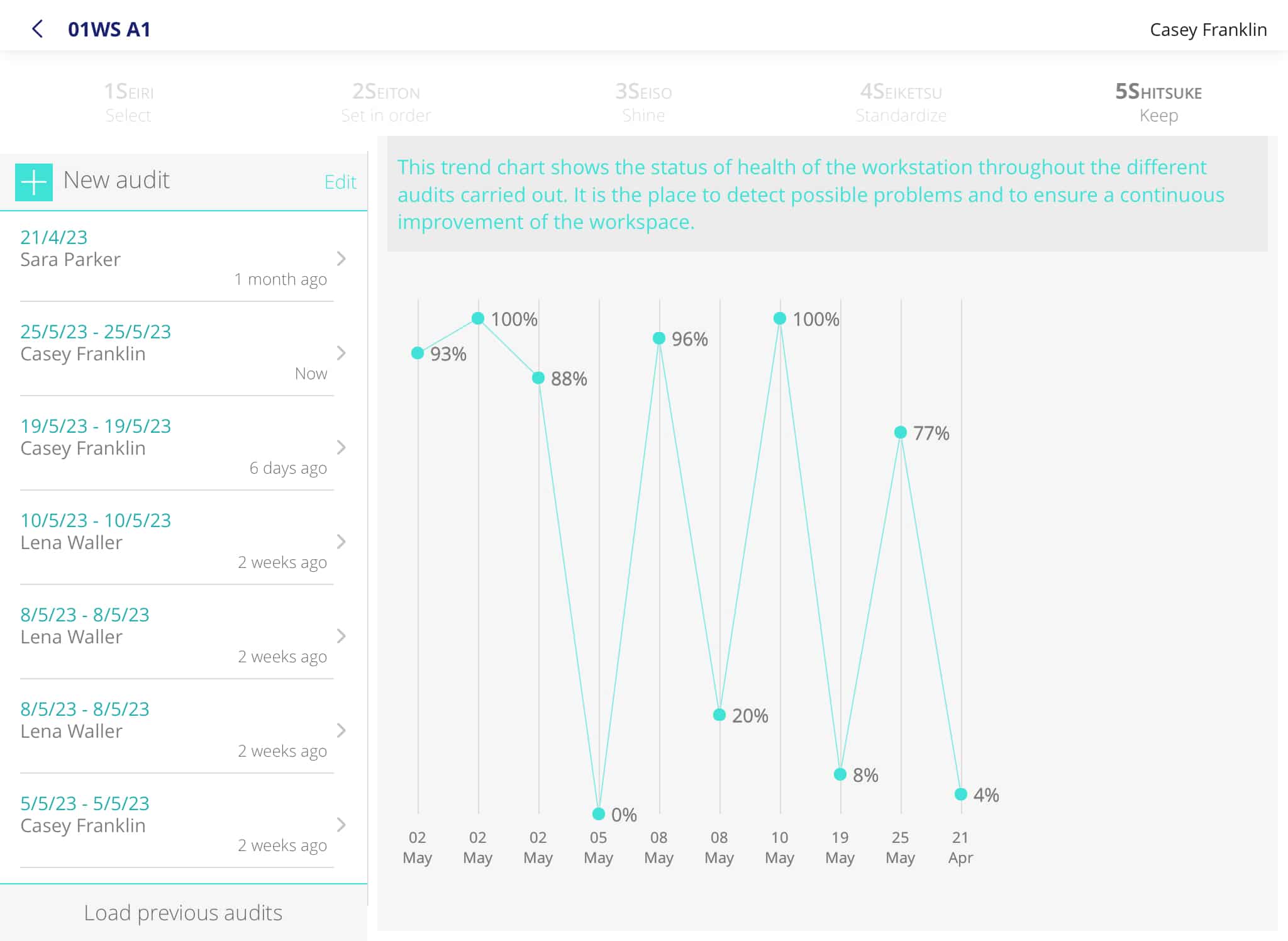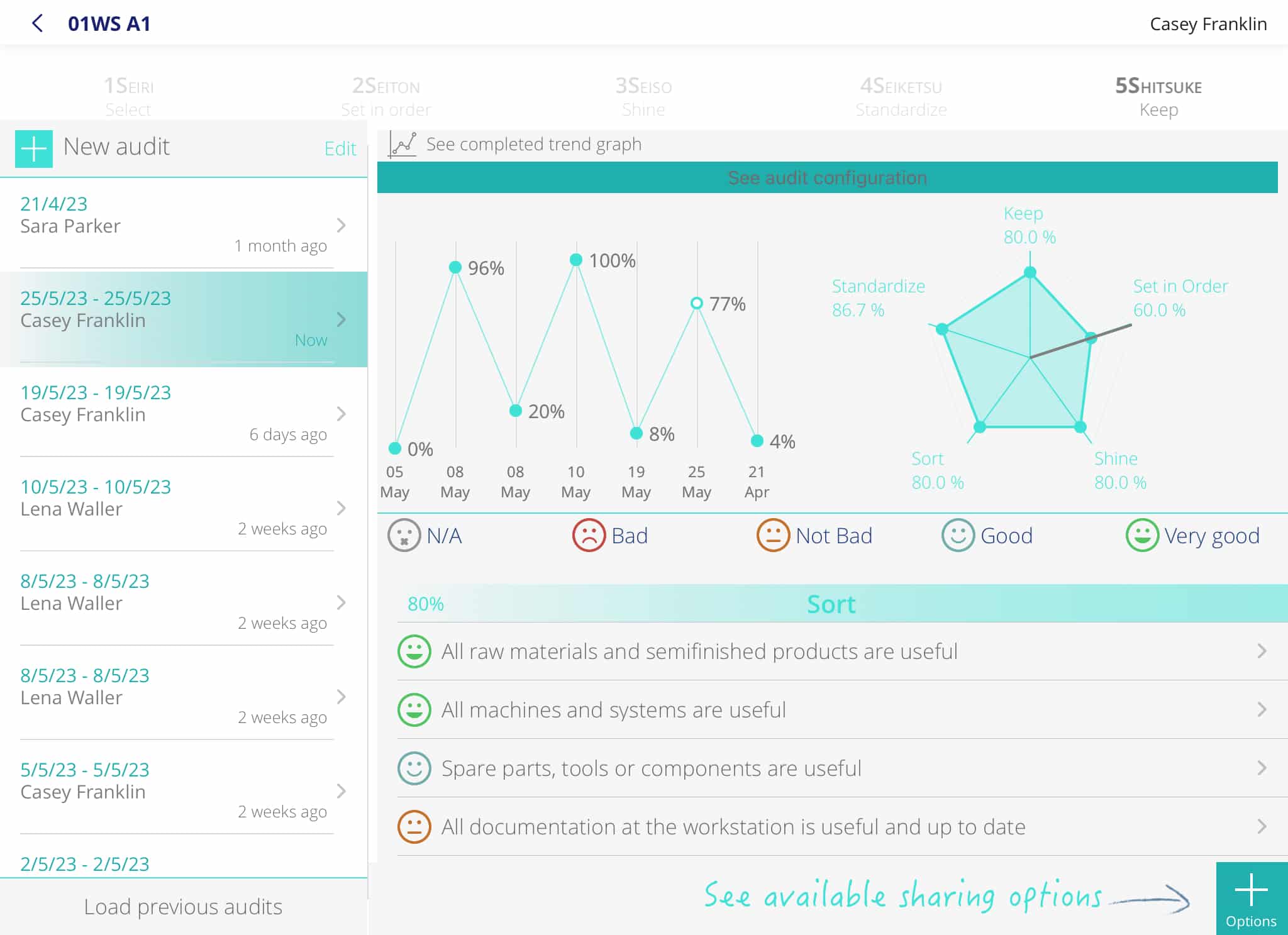If you want to make sure you implemented something right, you need to run regular checks on it from time to time to make sure it works. That’s where the 5S Audit comes in.
And what’s the best way to ensure we’re not leaving anything out when auditing something?
The answer might surprise you —a good old checklist.
Let’s dig in.
What is 5S?

The 5S is a very popular method developed by Toyota in the 60s, which is at the heart of lean manufacturing.
This method increases your factory’s safety and productivity while boosting the value of your whole production chain.
It follows five steps, although a sixth S was included in later years to include safety.
These steps are seiri (sort), seiton (set in order), seiso (shine), seiketsu (standardise), and shitsuke (sustain).
What are the advantages of implementing 5S?
The 5S method focuses on efficiency and optimisation, bringing you a safer factory, a more productive workforce, and higher quality throughout your production chain.
The 5S method can improve your efficiency by at least 30%, which increases your profitability, cost-effectiveness, and motivation.
This method makes you more competitive, as it helps you reduce waste, optimise what’s already working, and stay ahead of the game.
What is a 5S Audit?
A 5S Audit is a tool to ensure the 5S implementation works.
These types of audits can happen monthly, quarterly, or as often as needed.
To do a 5S audit successfully, you must use a checklist with specific questions for each S in the 5S method and decide whether the questions are met with an OK or NOK.
Let’s take a look at some of the questions you should be asking yourself when carrying out a 5S Audit.
5S Audit checklist example questions
Seiri (sort) — You’ll find questions about optimising the elements in the workplace, such as materials, machines, and storage space. The first S is about reducing waste. This means eliminating unnecessary items in the workplace and ensuring the area is free of elements without value.
Seiton (set in order) — You’ll have questions about the location of corridors and work spaces, teams and machines, and signs on display. The second S is about using the area efficiently and reducing the number of moves following the four principles of movement economy. Materials, equipment, and tools should be colour-coded and kept in their designated place.
Seiso (shine) — At this stage, we’re looking at questions dealing with the cleanliness of the workplace, tools, and machines. The third S is about creating and keeping a clean space and eliminating the sources of dirt to avoid safety, production, and quality problems, to name a few.
Seiketsu (standardise) — Here, the questions deal with standardisation and visual instructions. The fourth S is about creating and adhering to standards using visual guides to ensure the standards aren’t dropping.
Shitsuke (sustain) — You’ll have questions about maintenance, such as what audits you’re conducting, how you deal with problems that arise, and what measures you are taking to implement continuous improvement. The fifth S deals with sustaining the system you’ve built, mainly through repetition, continuous improvement, and implementing the PDCA cycle.
This checklist helps you identify your strengths and improvement points. It also helps you check that your workforce applies the 5S principles consistently and abides by the standards you established.
One thing to note is that ensuring that the problems you detect are fixed permanently is even more important than the audit.
To do this, follow these steps:
- Assign the task to the most suitable person to deal with it
- Be very clear when defining the improvement plan
- Adhere to deadlines
- In your next audit, verify that the problems that arose in this one are gone for good
How to complete a successful 5S Audit
Whether an internal or external auditor carries out the audit, there’s a standard set of things to include in your checklist to ensure you’re not leaving anything out.
One of the most important things is ensuring that the person in charge of the process has had the relevant training to conduct the audit. This is key for a smooth and accurate process.
Then, you need to use the same audit checklist for every area of the organisation and everyone involved with the audit.
Another key task is to take all the data from the audit and record it in a graph. This way, you can see the evolution of your audits in the same area over time.
Take a look at the example of a 5S audit graph we put below. It’s from our 5S Audit module, showing the evolution of an audit dealing with the fifth S from May to April.

What to include in your 5S Audit checklist
Fundamentally, you want to include questions related to the 5S and make them specific for the place you’re auditing.
As a quick recap, your questions should deal with each one of the 5S, namely:
- Sorting your space out — anything that isn’t necessary must go. Reduce waste and store away anything you don’t use daily.
- Set everything in order — assign a place for everything, and keep it that way. Optimise the space to make movement easier and more ergonomic. Ensureeverything is clearly labelled and colour-coded for easier visual control.
- Keep everything clean — maintain cleanliness in the space by identifying the source of dirt, creating standards to address it, and taking action to eliminate or minimise it.
- Standardise — formalise the state of reference in your workstation, use visual guides, create or tweak operating methods, and unify response rules.
- Sustain — use the PDCA cycle to foster continuous improvement, conduct regular audits, and improve upon any problem you find.
Consequences of doing a 5S Audit without a checklist
Doing a 5S Audit without a checklist isn’t unheard of, but it’s probably not the best practice.
When doing a 5S Audit, you’re looking at many different moving parts. This means you need to make sure you’re not forgetting anything.
Even more important than not forgetting anything is ensuring you’re using the right questions for each of the 5S.
Without them, you won’t be able to reach the improvement level you need for each of the S. This would translate into wasted productivity, time, and resources.
mlean® & 5S Audit

5S audits are great to ensure you comply with the 5S, but it can be quite a nightmare when it’s all done on paper.
Your 5S audits are key to the correct implementation of continuous improvement in your factory, and we all know how paper tends to get lost.
So we created a platform where you can implement continuous improvement from one single place.
Our mlean® Production System (mPS) helps you implement 5S, conduct 5S audits, and much more.
This makes embracing continuous improvement easier, as you can follow up on any improvement actions in your audits and filter them by person in charge, date, or section.
And because everything is digitalised and safely stored away, you can access any data whenever and wherever.
You also get more robust control of your factory, processes, and workforce.
Book a free demo with us and see what our software can do for your factory today!
Book Your Free Demo!